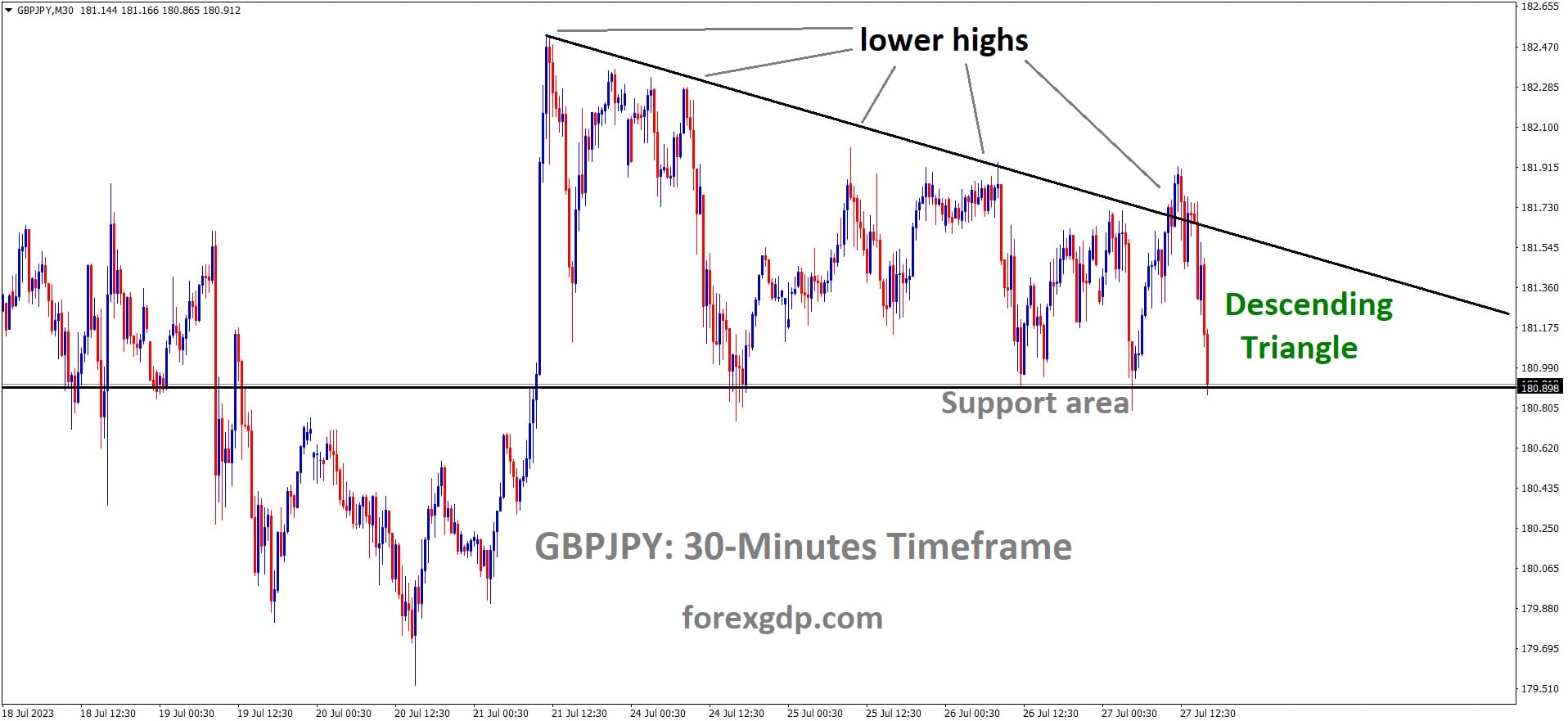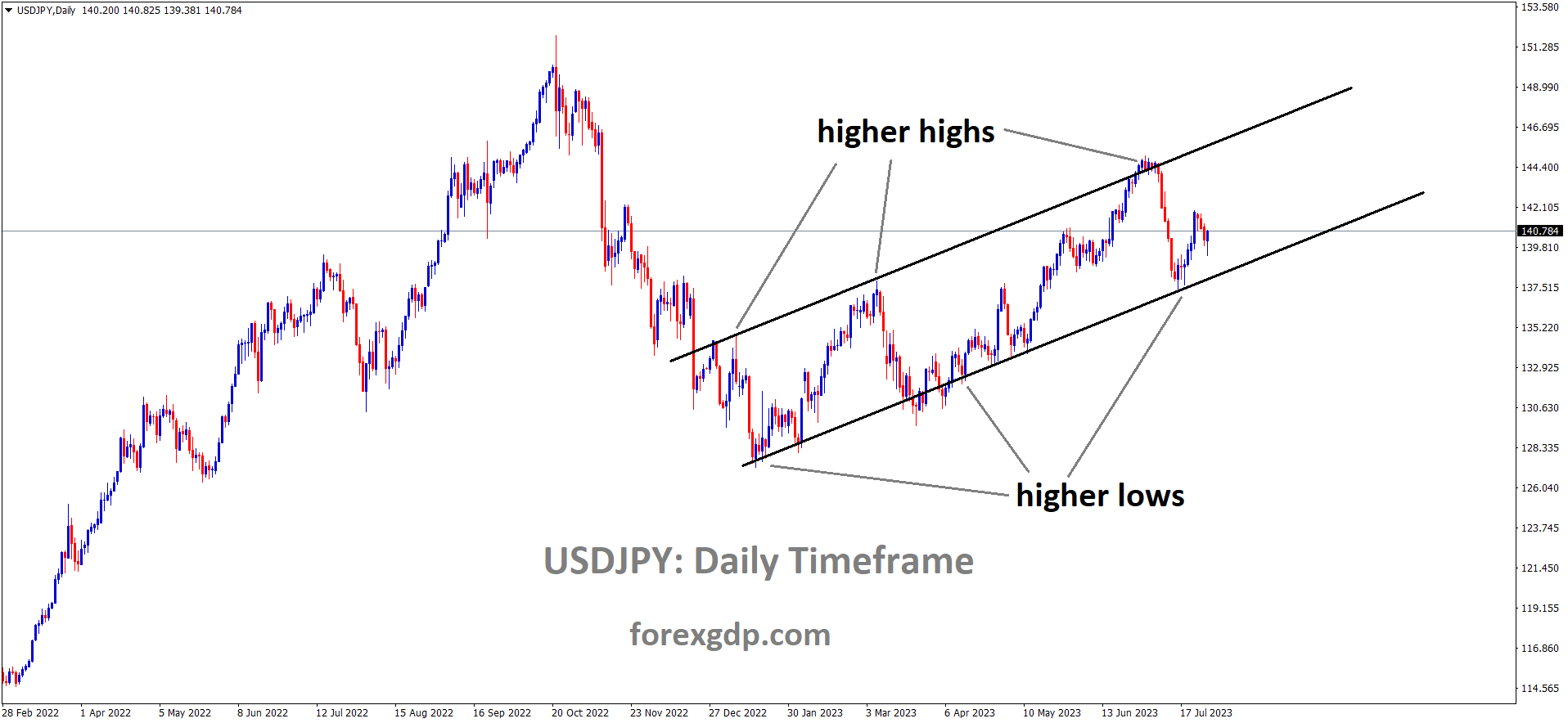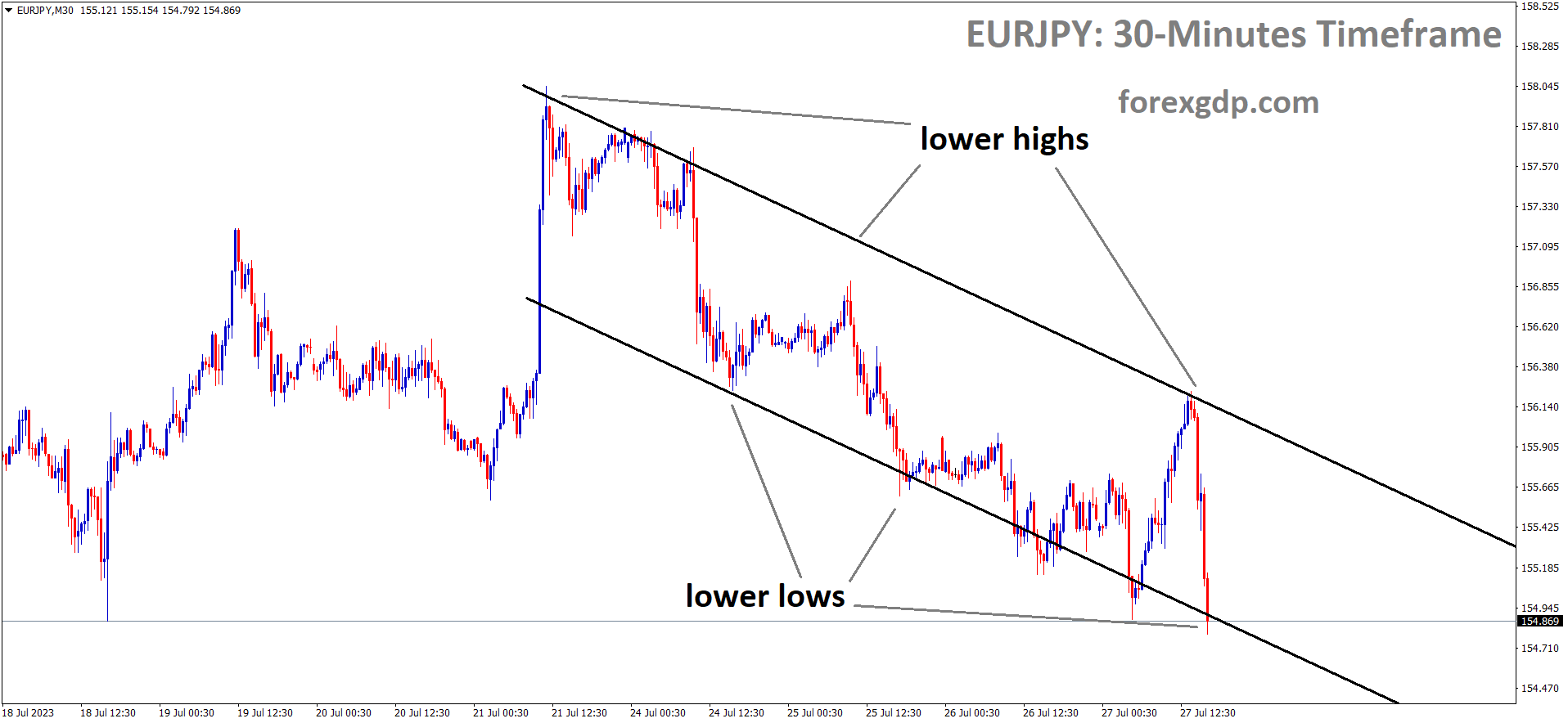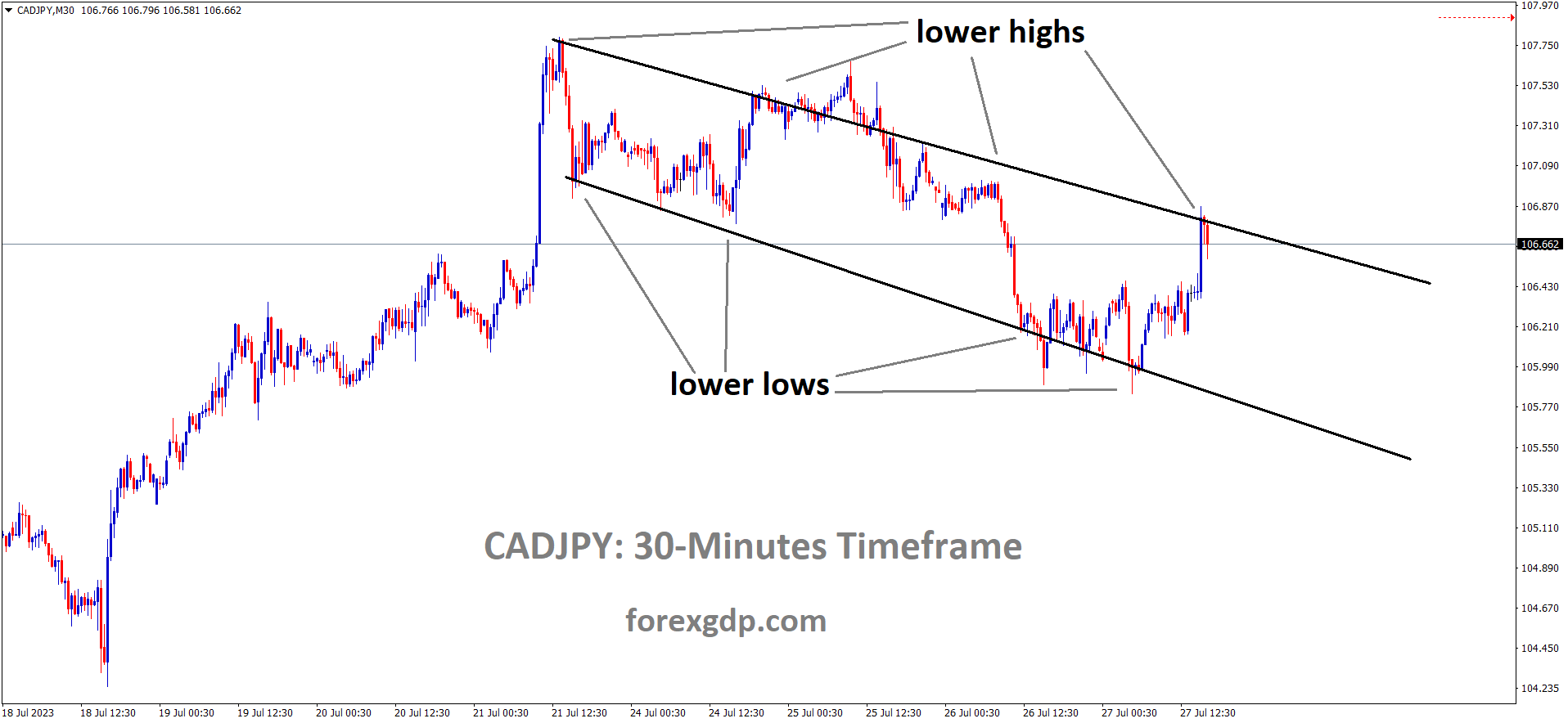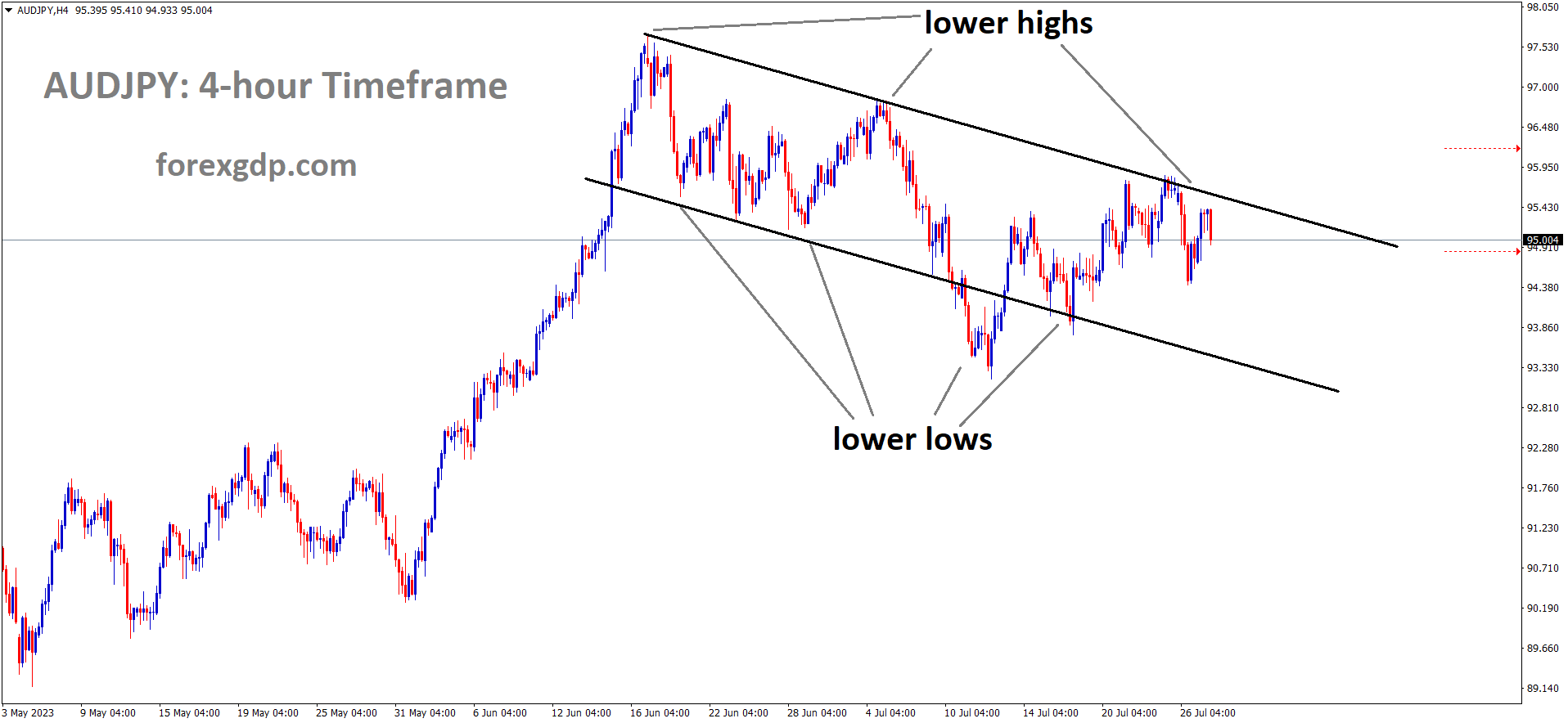GBPJPY is moving in the Descending triangle pattern and the market has reached the horizontal support area of the pattern
According to earlier statements from BoJ PM Kishida, the Bank of Japan is unlikely to implement a rate hike or make any adjustments to its Yield Curve Control during this meeting. Japanese firms are projected to generate sufficient profits and wages to support growth until the next year, hence the BoJ is expected to maintain the current status quo without any changes.
The Bank of Japan , like many central banks around the world, faces the challenging task of managing monetary policy to achieve stable economic growth and price stability. One of the key tools in its arsenal is the Yield Curve Control (YCC) policy, which has been employed as part of efforts to reflate growth and sustainably achieve the BOJ’s 2% inflation target. However, as inflation has exceeded the target for more than a year, the central bank is now confronted with the question of whether to make adjustments to its policy framework or maintain the status quo.
In this comprehensive analysis, we will delve into various aspects of the BOJ’s yield control policy, examining the factors influencing the central bank’s decision-making process, market speculations on potential changes, and the impact of core inflation trends on the BOJ’s policy outlook. Moreover, we will explore the significance of wage growth and the Japanese economy’s deflationary mindset in the context of the central bank’s quest for sustainable inflation.
1. The Bank of Japan Contemplates Yield Control Policy Stability
The BOJ’s yield curve control policy is a critical component of its monetary framework. Under YCC, the central bank targets short-term interest rates at -0.1% and aims to keep the 10-year government bond yield around 0%, with a 50 basis points allowance band set around the target. The primary objective of this policy is to support economic growth, maintain price stability, and achieve the elusive 2% inflation target.
However, with inflation continuing to surpass the 2% mark for an extended period, the BOJ must evaluate the effectiveness of YCC in achieving its goals. Policymakers are currently leaning towards maintaining the policy unchanged, preferring to scrutinize more data before deciding on any adjustments. One of the key considerations for the BOJ is whether the recent increase in inflation is sustainable, which hinges on corporate profits and the wage outlook for the coming year.
2. Divergence of Views on Phasing Out Stimulus Amidst Inflation Exceeding Target
Inflation has remained above the BOJ’s 2% target for a considerable period, leading to speculations about when the central bank might start phasing out its stimulus measures.
USDJPY is moving in an Ascending channel and the market has rebounded from the higher low area of the channel
Some market players believe that the BOJ could tweak the allowance band around its yield target to address market distortions caused by its heavy bond buying. However, there is no consensus within the central bank regarding the timing for such adjustments, making the decision on whether to begin scaling back stimulus a close call.
BOJ Deputy Governor Shinichi Uchida’s remarks about being mindful of the side-effects of the policy fueled market expectations of a possible tweak to the 10-year bond yield ceiling. Still, BOJ Governor Kazuo Ueda’s recent comments suggest that the threshold for dialing back stimulus remains fairly high. This divergence of views reflects the complex challenges the BOJ faces in navigating its monetary policy to ensure economic stability and sustainable inflation.
3. Market Speculation Surrounds Tweaks to Yield Curve Control (YCC)
With inflation consistently exceeding the BOJ’s target, markets have been buzzing with speculation about the possibility of adjustments to the yield curve control policy. Some players anticipate that the BOJ might widen the allowance band around the yield target to address market distortions caused by its bond buying activity. However, given that the 10-year yield has been stable below the 0.5% cap, many BOJ policymakers see no immediate need for fresh measures to tackle the side-effects of YCC.

Despite the speculation, analysts believe that even if the BOJ were to make tweaks to the policy, it would likely be minor fine-tuning to ensure the sustainability of YCC. The central bank is expected to keep its major policy levers unchanged in the near term, as policymakers continue to assess the economic landscape for more clarity on the global economy’s trajectory and Japanese firms’ ability to sustain wage hikes.
4. Factors Influencing BOJ’s Policy Decision: Global Economy and Wage Outlook
The BOJ’s policy decision-making process is heavily influenced by the prevailing economic conditions and outlook, both domestically and globally. Policymakers are closely monitoring the global economic situation to determine whether it can avoid a hard landing, which is crucial for Japanese firms’ profitability and their ability to continue raising wages in the coming year.
EURJPY is moving in the Descending channel and the market has reached the lower low area of the channel
Furthermore, the key to the BOJ’s policy stance lies in assessing whether the current increase in inflation is sustainable. This assessment relies significantly on corporate profits and next year’s wage outlook. Sustained wage growth is seen as an essential condition for the BOJ’s exit from ultra-loose policy, but policymakers are cautious about potential uncertainties and deflationary sentiment that may hinder wage growth sustainability.
5. BOJ’s Policy Framework and Inflation Projections
Despite the speculation and market expectations, the BOJ is likely to make no changes to its policy framework in the near term. Quarterly projections released after the meeting are expected to show an upward revision of core consumer inflation forecasts for the current fiscal year. However, projections for fiscal 2024 and 2025 are expected to remain largely unchanged from the current estimates.
Under the current forecasts, the BOJ expects core consumer inflation to reach 1.8% in the current fiscal year, rising to 2.0% next year, and then moderating to 1.6% by 2025. Core-core inflation, which excludes the impact of volatile fresh food and energy prices, is projected to hit 2.5% this year, 1.7% next year, and 1.8% in 2025. The BOJ’s focus on these projections reflects its commitment to achieving its inflation target and ensuring economic stability.
6. Assessing the Timing for YCC Adjustments
One of the critical decisions facing the BOJ is when to make adjustments to the YCC policy. While a hike in short-term rates remains distant, the timing for tweaks to the yield band is subject to a careful balance of benefits and costs associated with YCC. Market speculations on this matter have varied significantly, with some economists predicting adjustments to the 10-year yield fluctuation range or a change in the control target to a shorter yield.
CADJPY is moving in the Descending channel and the market has reached the lower high area of the channel
Analysts are divided on when the BOJ will end YCC altogether, with some suggesting a timeline later this year, while others anticipate it happening in 2025 or beyond. The interest rate differential between Japan and the United States is also considered in the decision-making process, as it has implications for yen volatility. The BOJ’s stance on these issues will have a substantial impact on the overall market sentiment and currency movements.
7. Japan’s Deflationary Mindset and Wage Growth Outlook
Japan’s economy has been plagued by deflationary pressures for years, leading to a cautious approach in the BOJ’s policy decisions. While there are signs of change in the deflationary mindset, analysts believe it is still largely sentiment-driven rather than a substantial shift. The BOJ recognizes that overcoming this deflationary mindset is crucial for ensuring sustainable economic growth and achieving its inflation target.
A critical aspect of the BOJ’s policy considerations is wage growth. Japanese companies offered their most substantial pay hike in three decades, compensating workers for the rising cost of living. BOJ officials regard sustained wage growth as a necessary condition for exiting the ultra-loose policy. Analysts are split on whether next year’s wage growth will be strong enough for the BOJ to consider normalizing its monetary policy, reflecting the uncertainty surrounding the economic landscape.
8. Market Volatility Ahead of BOJ and Fed Policy Decisions
The BOJ’s policy decisions are closely watched by global markets, and speculations surrounding YCC adjustments and monetary policy normalization have contributed to increased market volatility. Currency markets, in particular, have experienced significant fluctuations, driven by mixed views on the timing of potential BOJ actions and the Federal Reserve’s stance on interest rates.
AUDJPY is moving in the Descending channel and the market has fallen from the lower high area of the channel
The yen’s volatility against the dollar and euro has been affected by reports and remarks from BOJ officials. The yen’s movements have implications for the Japanese government, which may consider intervening in the market to stem the currency’s decline. Market watchers and economists hold varying views on the potential levels at which intervention may occur, depending on market conditions and economic considerations.
9. Core Inflation Trends and Their Impact on BOJ’s Policy
Core inflation in Japan has consistently exceeded the BOJ’s 2% target for an extended period, indicating the persistence of commodity-driven price pressures. However, the rate of increase in core inflation appears to be moderating, as seen in the recent slowdown in the index stripping away both fresh food and fuel costs. This suggests that the rapid pace of price increases seen in previous months, driven by cost-push factors, may have peaked.
The BOJ closely monitors trends in services prices, as they indicate whether inflation is becoming driven more by higher labor costs. The recent slowdown in services price growth indicates that wage pressures have yet to build up enough to warrant immediate adjustments to the ultra-loose monetary stance. Nevertheless, the BOJ must assess the potential for sustained inflation, especially considering wage hikes resulting from recent negotiations (shunto).
Conclusion
The Bank of Japan’s yield control policy decision is a delicate balancing act, influenced by a multitude of economic factors and market expectations. As inflation continues to exceed the 2% target, the central bank faces pressures to normalize its monetary policy. However, policymakers are cautious about the sustainability of inflation and the deflationary mindset that still lingers in Japan’s economy.
The BOJ’s assessment of global economic conditions, wage growth outlook, and core inflation trends will play a pivotal role in shaping its policy decisions. While market speculations swirl around potential tweaks to the yield curve control policy, the central bank is likely to prioritize data analysis and scrutinize inflation sustainability before making any adjustments.
As the global economy evolves, the BOJ’s monetary policy approach will remain under constant scrutiny. With market volatility on the rise, central bank communication and transparency will be crucial in managing expectations and maintaining financial stability in Japan and beyond. As the journey towards sustainable inflation continues, the Bank of Japan’s actions will undoubtedly have far-reaching implications for the country’s economic trajectory and the global financial landscape.
Don’t trade all the time, trade forex only at the confirmed trade setups.
Get Live Free Signals now: forexgdp.com/forex-signals/

